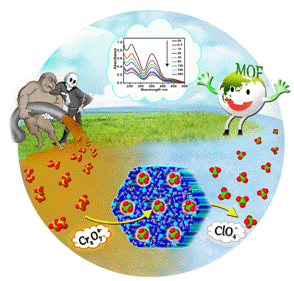With the development of modern industry, the contamination of hexavalent chromium [Cr(VI)] has become a more and more severe problem. Cr(VI) complexes have been widely used in the field of chromium plating, metallurgy, pigment manufacturing, leather tanning, and wood preservation.
Although traditional materials, such as adsorbents, resins and membranes, have been applied to remove Cr(VI) species in water, their inherent drawbacks, such as poor selectivity and slow process kinetics, limit their further development and application. It is of great interest to develop new materials for the efficient capture and separation of Cr(VI).
Prof. WANG Ruihu’s research group at Fujian Institute of Research on the Structure of Matter, Chinese Academy of Sciences, has reported a cationic metal-organic porous material for separation, recognition richness of dicromate in water.
The material was easily prepared by self-assembly of neutral bitriazole ligand and silver perchloride. Similar to the features of exchange and separation of ionic complexes, the cationic material can fast capture and separate dichromate anion through a single-crystal to single-crystal anion exchange process.
The most important thing is that the material shows excellent enriching ability toward extremely low-concentration dichromate, more than 10ppm dichromate can be completely enriched. The whole process can be simply monitored by UV-Vis spectra and observed by naked eyes due to the obviously color change between perchlorate and dichromate.
Moreover, the material features a bluish violet luminescence, which is distinctly quenched upon dicromate exchange, which can be used as a luminescent probe of dicromate. This result not only widens the applications of porous materials in separation and enrichment of dichromate in water, but also provides a new approach to development of materials in heavy-metal recognition, separation and enrichment.
Results of this study have been published on Angew. Chem. Int. Ed. 2013, 52, 13769 -13773.

The scheme for separation, recognition and richness of dicromate in water by cationic metal-organic frameworks(Image by Prof. WANG’s group)
CONTACT:
Prof. WANG Ruihu
Fujian Institute of Research on the Structure of Matter
Chinese Academy of Sciences
Email: ruihu@fjirsm.ac.cn